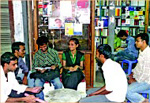 Much of contemporary literary and critical theory is dominated by French philosophers. To draw a reason why the French have the upper hand in critical thinking and philosophy, Jim Powell, in his book on postmodernism, jokingly wrote that for decades, French intellectuals — mostly regarded as national treasures and celebrities — sat at cafes, placed orders, fumbled for cigarettes, thought about things and presided over a lot of table talks. That is how, according to him, French philosophers were “made”.
Much of contemporary literary and critical theory is dominated by French philosophers. To draw a reason why the French have the upper hand in critical thinking and philosophy, Jim Powell, in his book on postmodernism, jokingly wrote that for decades, French intellectuals — mostly regarded as national treasures and celebrities — sat at cafes, placed orders, fumbled for cigarettes, thought about things and presided over a lot of table talks. That is how, according to him, French philosophers were “made”.
During the last couple of decades, if anyone took a walk around Aziz Market, he/she would have found a similar ambiance at the restaurants/cafes in the vicinity and adjacent sidewalks. People of different ages, and obviously of considerable intellect and taste, are seen chatting about philosophy, politics or just sitting languidly over a cup of tea and contemplating. From these informal table talks and interminable kicking back, many popular filmmakers, actors, theatre activists and writers have emerged.
Writers and poets of this generation like Sajjad Sharif, Sanjib Purohit, Bratya Raisu, Shantanu Chowdhury, Alfred Khokon, and artists like Ronni Ahmed, Mustafa Zaman, Mamun Kaiser and several others had spent a considerable length of time at and around Aziz Market. It is understandable that the adda (informal gathering) had made a significant contribution to their making. Also noticeable was the presence of left-leaning (socio) political organisations in the area; many of them had their offices on the 2nd and 3rd floors of the market. Accomplished filmmakers and actors like Mostofa Sarwar Farooki, Marjuk Russel, Animesh Aich and many others were seen hanging out here even after they had become celebrities.
Artist Nisar Hossain along with his contemporaries like Dhali Al Mamun, Dilara Begum Jolly, Habibur Rahman, Shishir Bhattacharjee, Saidul Haque Juise formed an artists’ circle called ‘Somoy’ in the 1980s and met here. These individuals had also made significant contribution to the contemporary art scene of Bangladesh.
However, an obvious question is, of all the places, why did Aziz Market become the hub of all these intellectual hubbubs?
For one thing, the rather unattractive building in which publishing houses and book shops began to gather was pretty close to Dhaka University. Some people called it boi para [neighbourhood of books]. So the students and academics involved in progressive cultural and political organisations went there to find their desired books that were not available in the traditional and more commercial bookshops at Nilkhet and New Market. Realising the demand, bookstore owners offered foreign books on philosophy, literature, social science and other subjects that were of particular interest to these voracious readers.
Moreover, most of the Dhaka-based literary periodicals or little magazines were housed at Aziz Market. That also brought numerous young writers and poets to this place. Cutthroat debate on cultural theories like modernism and postmodernism, or discussion on a poem setting the table on a roar, were common features there.
However, over the last few years the place has gone through a transformation. Instead of the grumpy literary critics, the market is being taken over by mostly fashion enthusiasts and shopaholics. Most of the bookstores and publishing houses, socio-political groups, literary magazines have left the building.
“The transformation of Aziz Market is related to other economic factors. You can see it as an effect of the free market economy,” said Firoz Ahmed who has been a regular at the market for years. Indeed many of the bookstores can’t simply afford to be here anymore. The little magazine movement is also on the wane. And the grey anonymous shops of publishing houses are replaced by well-lit, colourful clothing stores.
However, a few book and record stores that still remain here draw academics and ardent readers to the market.
Courtesy of The Daily Star




















